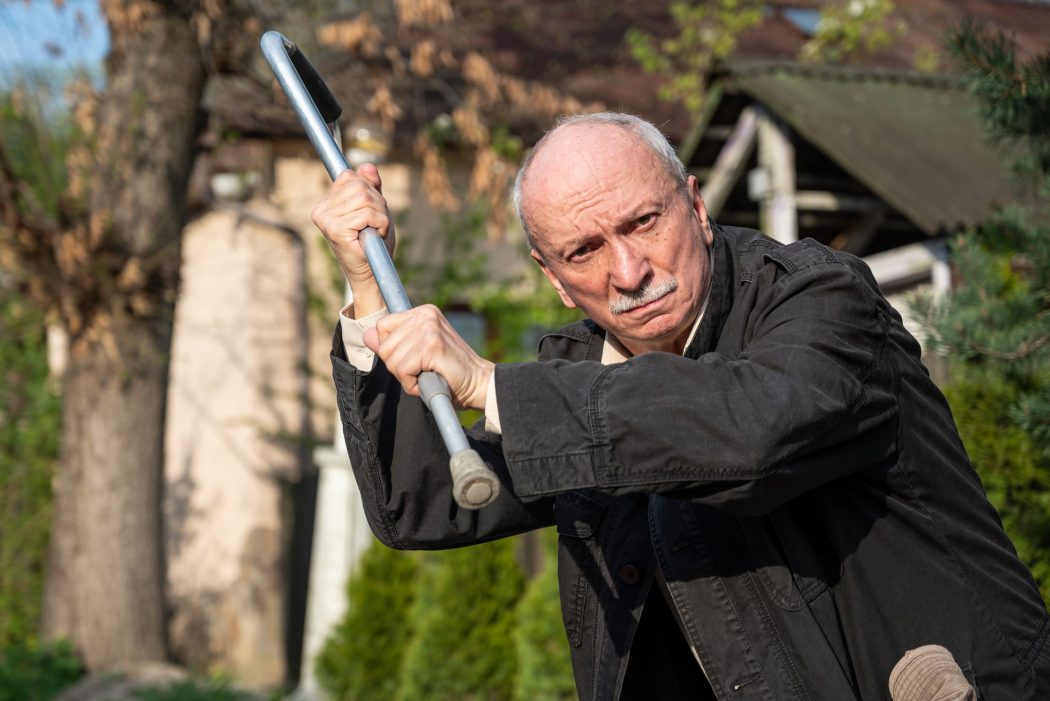
I highly recommend training to use a cane, walking stick, or a traditional full length umbrella.
This is particularly important for our readers that live in gun-unfriendly states.
Ditto if you live in states like California, New York, and New Jersey where it’s very difficult for mere mortals to get a carrying concealed weapon (CCW) permit.
And even if you are a concealed firearms permit holder, you should learn these valuable skills.
Why? You never know when circumstances might dictate that you cannot carry a pistol. (For example, when traveling to a state where your CCW permit is not valid, or when traveling overseas.)
An undercover cop recently told me why him and his colleagues love using canes, walking sticks and even umbrellas during any street combat scenario.
I was astonished at the number of effective moves available to the cane/stick fighter.
Range is the big advantage that canes have over blades and other impact weapons.
Striking and jabbing are still the premiere moves, easily done with nearly any style of cane.
Some follow-up moves and holds and more comfortably accomplished with a hooked cane than with a straight stick, but either style works just fine.
The real question is: What can I have with me most often that attracts the least attention?
The cane is a wonderful, low-profile, yet extremely effective fighting tool that most people can fit into their lives with a minimum of lifestyle disruption.
Most casual observers don’t even notice when you have one with you and certainly don’t believe them to represent a threat.
As for walking stick designs: From what I have heard and observed here in the U.S., if you are well dressed and groomed, then law enforcement officers in most jurisdictions will hardly give you a second glance if you are carrying a walking stick.
But if you are shabby looking and perceived as “riff-raff”, then expect to get plenty of grief.
Canes, especially aluminum ones that look like true walking aids, are far less likely to attract suspicion than walking sticks.
I have an acquaintance who lives in Oakland, California who carries a dull silver aluminum cane with a big rubber tip.
This cane looks very unobtrusive if not downright innocuous. It is not until you pick it up that you realize that it has been retrofitted with a 1/2″steel rod firmly epoxied into its hollow core. The phrase “the iron fist in the velvet glove” comes to mind!
I have another acquaintance that lives in a very rainy climate, near Seattle, Washington. He makes a habit of carrying a stout full length traditional umbrella whenever he gets out of his car.
Aside from misplacing several umbrellas over the years, he had no trouble. (And, by God’s grace, he has only had need to use it to protect himself from rain showers.)
Nearly all of the stick/cane fighting techniques apply to folded umbrellas, and they can also be used quite effectively for jabbing.
My general preference is to use a well-spaced two handed grip grip in most situations, to maintain control and more importantly to assure retention of the stick.
This is akin to what has been taught for many years by police academies in the use of long (“riot”) batons.
The last thing that you want to happen is to have Mr. Bad Guy gain control of your weapon. If that were to happen, you would become the “Owie” recipient instead of the Owie distributor!
Do some research on your local laws. In most jurisdictions, any blow with a striking weapon to the neck or head is considered potentially lethal.
Police academies emphasize this in their baton training. (“Never strike above the chest unless you would in the same circumstances draw your pistol and fire.”)
So don’t escalate to doing so unless you are absolutely confident that your life is threatened and you have no other choice.
It may sound sissified and a bit too prim and proper but most courts look at things in terms of equal force and a graduated response, roughly as follows:
If Mr. Bad guy uses his fists, then you can use your fists. If he uses a weapon, then you can use a weapon. If he strikes above the chest, then you can strike above the chest.
As a practical matter, there are no rules in trying to save your life in a street fight, but apparently there are in courthouses.
Yes, I realize that graduated response is not realistic to expect, since street fights are fast and furious.
Most victims don’t even recognize that their attacker is using a weapon until after the incident is over.
But again, a graduated response is what courts will expect in order to make a ruling of justifiable self defense.
If you get into an absolutely lethal brawl (a truly “kill or get killed” situation) and you cannot disengage, by all means aim where you can do the most damage: The front or side of the neck.
The human neck is soft tissue, a bundle of nerves, veins, arteries, and windpipe. It is your surest target to end a fight quickly and decisively.
The same goes for hand-to-hand combat. Aim your punches at his throat.
But again, it is also your surest way to find your way to a courtroom. I can’t stress this enough: show discretion!
When carrying a striking weapon or an edged weapon of any sort for self defense, be sure to develop the same Condition White/Yellow/Amber/Red situational awareness skills that you would for carrying a concealed firearm.
